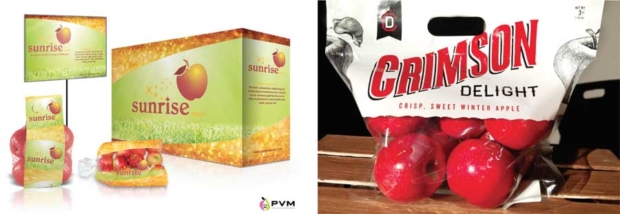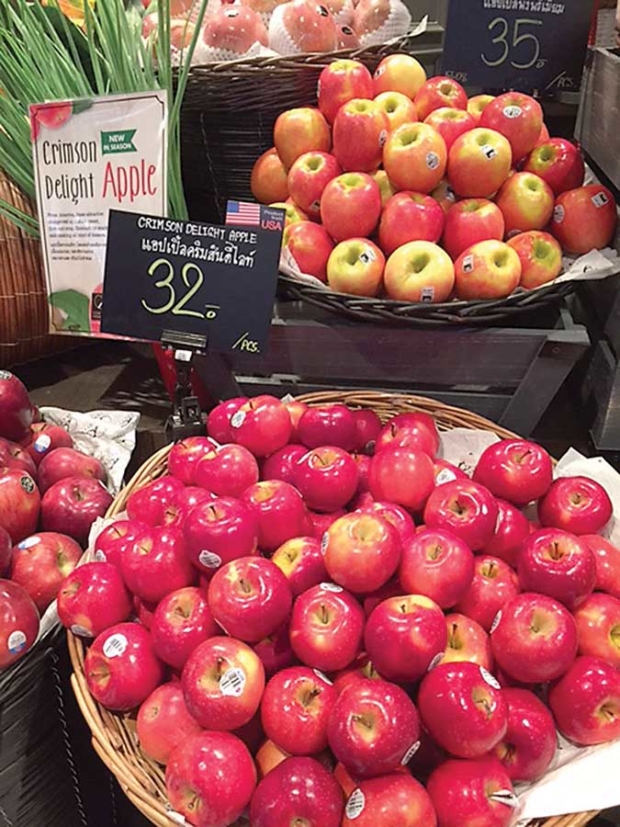
Washington State University’s attempt to rebrand the new variety WA 2 may leave the industry with two names for the same apple, as the university continues to negotiate with a packing company that developed its own name and logo a year ago.
The university wants to call the apple Sunrise Magic, while a Yakima, Washington, packer has already labeled it Crimson Delight.
While breeders are pleased their apple — released nameless in 2011 — will get a new push, the two marketing efforts are causing confusion in the industry.
“If you wanted a blueprint for bungling a new product introduction, that was it,” said Desmond O’Rourke, a fruit industry analyst from Pullman, Washington, who is not involved with either trademark.
In February, the university and a contracted variety management firm announced they had trademarked the brand Sunrise Magic for WA 2, adopting a logo that features a red apple with a golden gleam rising as if a sun over the name in lowercase script.
However, packer Apple King last year trademarked the name Crimson Delight with its own logo, packed 500 bins during the 2015-2016 season and is now trying to expand.

The two sides are negotiating about what happens next.
The university is offering contracts to any orchardist to purchase the trees and market the fruit under the name Sunrise Magic, paying royalties to the college for each tree and each box sold.
Existing growers may continue and even expand their own WA 2 orchards using any name they wish, but new growers would have to use Sunrise Magic, said Jim Moyer, WSU associate dean of research.
“There’s potential for confusion any way we go,” Moyer said.
University officials want to establish a precedent for how they introduce new varieties of apples, raspberries or grains, he said, and allowing too much negotiation on the WA 2 could undermine that precedent.
“We’re trying to get all of our commercialization in alignment,” he said.
More than anything, Apple King wants to recruit new growers under the Crimson Delight trademark, said Ray Keller, one of the company’s partners.
They do not plan to seek their own royalties from new growers or other packers who use the Crimson Delight name, though royalties may become part of the negotiations with WSU, Keller said.
“We’re willing to compromise,” Keller said.
He declined to share how much Apple King spent developing the Crimson Delight brand, calling it only “a substantial amount.”
Meanwhile, the confusion is causing some hesitation in the industry.
As of February, Washington nurseries affiliated with Northwest Nursery Improvement Institute had a supply of WA 2 trees and the ability to sell to any grower in Washington.
At least one was advising growers, however, to wait until Apple King and the university finalize their agreement, in spite of sizable interest.
“Before your tree goes in the ground, you have to have your marketing strategy,” said Stacy Gilmore, marketing manager for Cameron Nursery in Eltopia, Washington.
How things got here
Keller and his company did not invent the name Crimson Delight.
The university’s breeding program released the WA 2 in 2011, allowing the Washington State Tree Fruit Research Commission, funded directly by growers, to handle the distribution and licensing of the variety.
Staff suggested the name Crimson Delight and let 128 growers purchase test plots of five trees each.
Some growers purchased more than one.
Most of them never took the propagation any further due to the lack of a marketing plan. The largest grower, who planted 3,300 of the trees, roughly 4 acres worth, grafted them to another variety.
“No one had a plan to do anything with it, to commercialize it,” said Bruce Barritt, the apple’s breeder. He has since retired and been replaced by Kate Evans.
In the end, only 24 growers received commercial licenses from the Research Commission, and most of them planted no more trees.
At the same time, Research Commission staff were still learning the quirks of the variety, namely that it needs about two weeks at room temperature to “wake the flavor,” said Tom Auvil, a commission research horticulturalist.
Industry sales and marketing representatives took one bite of what was otherwise a starchy, grainy apple and walked away. It wasn’t until later the Research Commission staff realized the potential.
“It was a mistake to offer new product to the marketing professionals prior to understanding the variety,” Auvil said. “A very severe learning experience.”
A few growers stuck with the WA 2, however, using the suggested name of Crimson Delight. Some of them are direct marketers, but most of the remaining growers packed through Apple King, which ships them both domestically and internationally.
Keller suspects the state has between 100 and 200 acres of WA 2 trees in the ground now, but his few growers have been propagated more.
Enter the Cosmic Crisp
Since then, the university released the WA 38 — also bred by Barritt — using a marketing plan and brand name Cosmic Crisp devised by Proprietary Variety Management, a Yakima, Washington, company contracted to commercialize new varieties. The university asked the company to do the same for WA 2.
The company chose the name Sunrise after two focus groups, one in Spokane and one in Seattle, came up with the term independently in early 2015.
The company then added Magic after a trademark attorney advised that two-word names have a better chance at approval from the U.S. Patent and Trademark Office. The logo was chosen in an online poll.
Only Washington growers are allowed to produce the WA 2 in North America for 10 years.
The management company is pursuing breeder’s rights to protect the brand in several overseas markets, too, said Lynnell Brandt, president of Proprietary Variety Management, or PVM.
Growers will pay $1.25 per tree, plus 4.75 percent of the sales price of each box over $20. The money goes to the university’s breeding program and the management company.
The university keeps the “vast majority” of the proceeds, Brandt said. Neither Brandt nor Albert Tsiu, the university’s technology transfer coordinator, would disclose how much the university pays PVM.
However, of the university’s portion, 50 percent will go to the breeding program, 30 percent to the breeder, 10 percent to the university for administrative costs and 10 percent to the university’s Office of Commercialization.
The breakdown is standard for any vegetatively propagated plant varieties, according to the faculty manual.
An apple with two names is nothing new, said O’Rourke, the analyst from Pullman. In the end, the market may decide which one sticks around.
For example, the Pink Lady brand, first trademarked in 1996, has drawn a stronger following than the generic name Cripps Pink, he said.
A brand, a name that tells a story and generates excitement, makes a big difference in the competitive apple industry, both with stores and consumers, he said.
“If you don’t have a clear name, title, … you’re not going to do very well in the marketplace.” •






There should be a poll on here for us to vote on which name we like.
I like that idea Chris!
Interesting story Ross. Researchers should never talk to marketing until they are absolutely ready. It’s fundamental in business. Auvil is right.
Thanks for giving the actual an valuable points of magic.